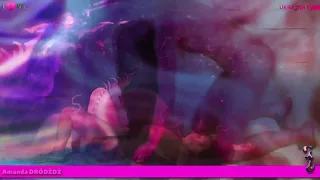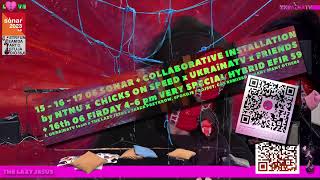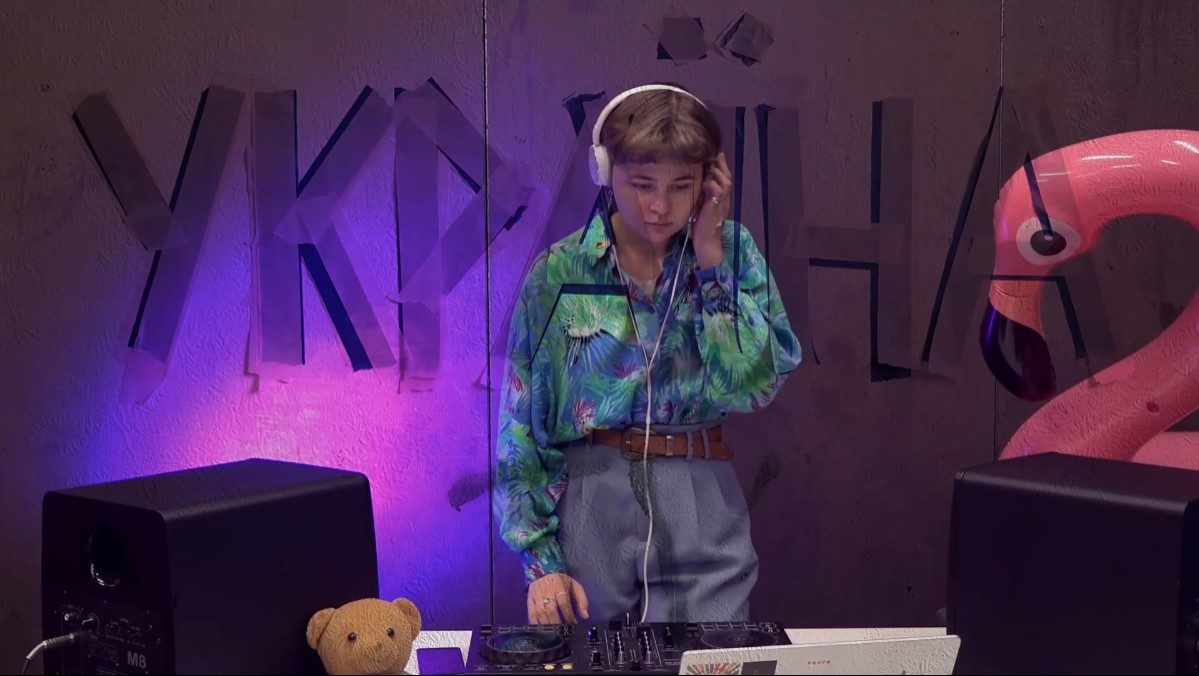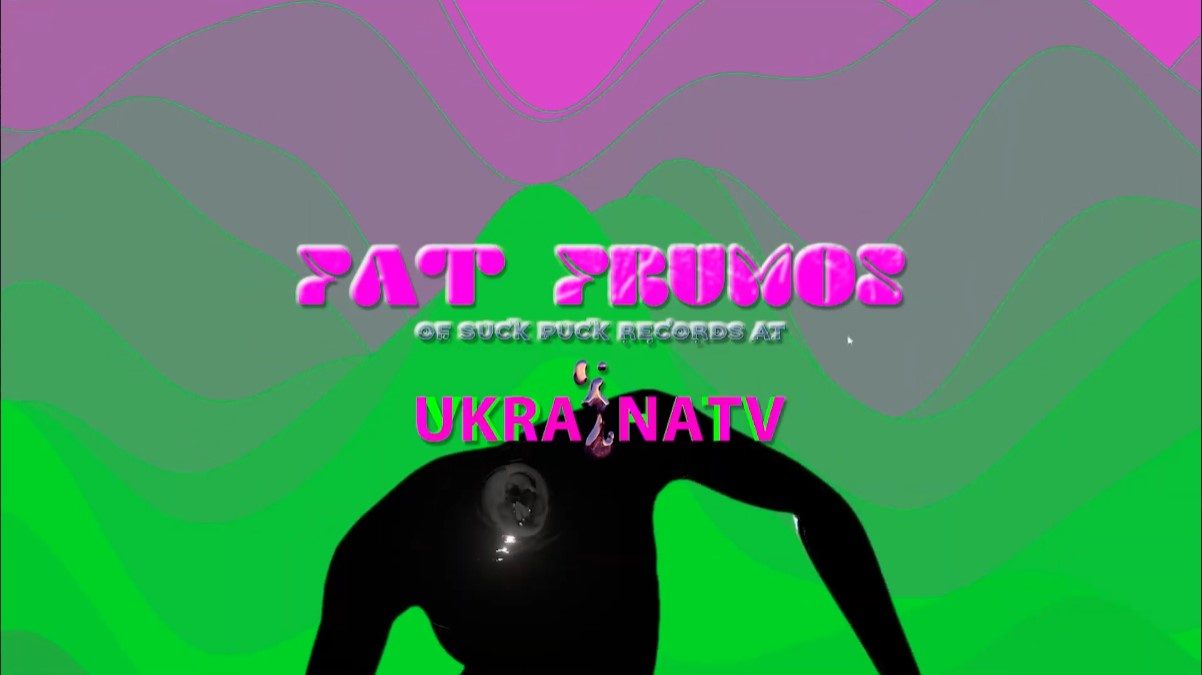Konrad Wojnowski: Broadcasting (and) Cleansing-Review of UKRAiNATV 24hr Live Stream


1
If my neural network was capable of producing a holographic representation of the hybrid performance/ritual I witnessed last week, both in the flesh and via video streams, what would it look like? What is the mental spectre left in my mind after sinking in the events of STANDBY – ЧАТУВАННЯ – CZUWANIE, “an experimental, collective art process of adventure”, that took place in UKRAiNATV’s broadcasting studio in Kraków on February 24? If stripped down to its statistical average (the essence as the ancients called it), it would probably be a head-spinning transposition of the imposing green room where everyone was gathered, of wires, cables, people in constant motion, of drastically shifting moods and intensities, of multiple screens pointed at me from different angles and showing the physical here-and-now against an ever-changing backdrop of some virtual elsewhere, people disappearing, or travelling to distant virtual worlds of which stuck in mind the most: the barren landscape of the virtual Snake Island, a place not to be admired but remembered. It was on this island where a tiny group of Ukrainian defenders audaciously refused to surrender and famously responded to the Russian warship “to go and fuck itself”. Soon, it became one of the most powerful and widely-spread symbols of improbable Ukrainian defiance and success in the face of adversity that from a distance seemed insurmountable at the time.
24th February 2022, the day when the Russians launched a full-scale invasion of the Ukrainian land, was one of those days which you remember weirdly vividly, or in the worst-case scenario, not at all, even if you should. Sometimes whole sequences of events get stuck in your head, sometimes, it might have been some random detail that you remember like it was just seconds ago, like the colour of the sky, a particular arrangement of bodies in space, a smell, a look at someone’s face. Let’s not be afraid to call it for what it was – a day of mass trauma when memories of people go haywire and the past sticks out uncomfortable. The closer to the event one was, the more scarring it became. And anniversaries of disastrous events, which leave still open wounds, are an awkward endeavour.
It’s hard to say what was STANDBY about, or how one should label it. It is easier to say what it wasn’t: distant, formal, or threatening, even despite some chaos and uncertainty it produces. It morphed and shifted constantly, rarely settling on being one thing at a time. For 24 hours a group of freaks gathered to do some odd but important stuff together in the spirit of experimental openness and broadcast it online so they could leave, at least in some part, this forsaken gravity-bound existence, whereas other spectral beings could join them in the spiritual gathering.
The mood shifted throughout this long day: sometimes enthusiasm slowly took hold of the participants and faded away in due time. Other times the transitions were unexpected and abrupt. It all started without hurry, delicately, and a bit awkwardly I must say (side note: well-planned and executed social gatherings don’t come naturally in this part of the world; flawless execution is a good reason to suspect someone of being a phoney). Conversations were grave, the music was down, and the lighting dimmed. The mood shifted as people came and went and the in-flux of fresh bodies kept the eyes of those who stayed open.
Nonetheless, long-distant runners – Rom, Gleb, Giulia, Ksenia, Sofia, Blady-Ivan, Maiskyi, and Anastasia, the fortune-teller – had to undergo ever-shorter cycles of exhaustion and rejuvenation.
2
If the picture painted above looks quite messy and confusing to you, you’ve got the right impression. However, not only was there a method in the chaos but also a very good reason to foster it. Being in part an experiment piece in relational art (but in a modest and non-self-congratulatory sense of the term), it was also thought of, and quite openly, as a post-secular ritual gathering. It was linked – both substantially and conceptually – with the ancient mysteries that most probably originated from the territories that are now southern Ukraine, in particular, the eponymous Snake Island. The rituals travelled along trading roots further south and exerted a major influence on the Greeks who incorporated them into their own belief system by re-writing (or, rather, retelling) the tragic myth of Dionysus. Little is known for sure about these events, as they were shrouded in an aura of secrecy and their details were never to be disclosed to the outsider, nor even discussed publicly.
What happened in Eleusis, one of the most important sites of the Dionysian cults stayed in Eleusis. Incidentally, from these ceremonies, the ancient theatre would later emerge, conceived of initially as a more controlled activity, though, intended for the same purpose: to invoke the feeling of katharsis – of communal emotional cleansing. The mysteries themselves were probably more powerful and less structured than the theatrical gathering. The intention behind partaking in the ritual was to heal oneself by going through a chaotic experience of having been stripped of control over life but in the comforting presence of the community that becomes absolutely equal in its submission to the joyful but also cruel god, Dionysus.
Dionysus was a god of many things, but the mysteries celebrated him in his power to induce ecstasy, that is, letting go of societal inhibitions and the restrictive order of civilized and predictable life which suppresses all that endangers its tight control over the wild flow of life. The Greeks, at least those who did worship the god of disorder and Euripides in The Bacchaeexpressed a blunt warning against such act of defiance in the name of reason, knew that there was always something that could not be ordered. They knew that order, even though it was very much respected and celebrated through other customs and ceremonies, cannot – by its very design – account for the unpredictable, uncontrollable, but also inevitable ingredients of life. A wisdom that became very unpopular since the European Moderns took over the business on this planet.
This kind of intentional willingness to confront the complexity of experience and the over-arching ambivalence of STANDBY was in line with this basic principle of Dionysian mysteries. And what more suitable form for a ritual for healing wounds that cannot be yet fully closed. The war still wages so a ritual of closure is not yet possible. But, some form of katharsis is necessary and what better way to confront the exhausting ambiguity of having to live – which necessitates some form of enthusiasm and enjoyment – in the shadow of war than by engaging in the ambiguous, displaced, odd, but very heartfelt ritual like this.
3
STANDBY was open to the public which might have not known its physical location, but could participate through online channels, though, it should be noted, the anonymous and distributed tyrants of the platforms from Silicon Valley were not kind to the folks from UKRAiNATV, dumping its content for some time under more urgent content (as we all know, the constant innovation in the arts of make-up call for pushing such tutorials to the top of people’s feeds). Its physical location, though, brings to mind the sites of secretive Eleusian rituals. Located at the end of a courtyard within a courtyard, hidden behind a fence and a small garden, the place is not the easiest to find and creates a very peculiar atmosphere: in part raw and post-industrial, in part cute and almost pastoral (think of post-socialist workshop in Narnia).
UKRAiNATV settled here shortly after the escalation of the war as an attempt at creating a true hyperreal platform in which both the “hyper” (the beyond-ness) and the “real” (the immediate closeness) are taken equally seriously.[1] It is a someplace tighter, someplace looser knot of freaks, tech-whizzes, artists of all sorts, DJs, scholars and many other lost souls, cameras, cables (and a lot of them, seriously, people here have a weird thing for duct tape and extending extenders with extenders), digital interfaces, virtual worlds (and other within them), and lots of other components that together serve as a streaming hub, melting pot, and safe space for digital nomads, those by choice and those by necessity alike. And while functioning under the auspices of a public institution, the Academy of Fine Art in Kraków, it created a highly elusive and informal mode of working and collaborating – a postmodern nomad encampment à rebours: bound by its institutional and material determination, it allows for digitized nomadic excursions. The hardware, very capable but with an unashamedly D-I-Y feel, serves as the camp’s bonfire for locals to gather, transcend bodies, and come in contact with digital spirits. In other words, the main of the hub is not to unilaterally transmit some uniform message but to establish global connections and create new and inclusive aesthetic forms of fostering togetherness in flesh and through its extensions.
The persistent feeling of ambivalence that weaved everything into an ambiguous whole was thus very true to the elusive and amorphous identity of the group. During the long 24 hours, the cries often turned into laughter, playful interactions suddenly turned sour, talking-heads would head for the dancefloor when talking was over, or, to mention just of many ambiguous performances, Sofia Reznichenko’s seemingly restraining act of tying someone up was intended as tender act of care. And it is worth mentioning that broadcasting this act got the group banned from YouTube. The irony of this sadly predictable act of censorship is that the philosophical-existential meaning of contemporary Shibari practice revolves around hijacking a technique that was used for torture and subverting its purpose which, in this case, was additionally devoid of sexual undertones.[2]
Sarah Kane’s famous drama, Blasted, written in 1995 in the in-yer-face, brutal style, was based on the following literary premise which weirdly and strongly resonates with the most touching (solely unscripted) scenarios of events that happened that night. An average couple in crisis quarrels in their hotel room in Leeds while in the background the telly broadcast the news about some gruesome event happening in the Yugoslav Wars. When the violent content of the broadcast captures their attention for a moment, the realness of violence leaks into the safe and boring reality of some hotel room in some Western city. The world turn-upside down: bomb blasts through the wall and the atrocities of the war creep into and merge with the silent, depressed violence of the couple. A soldier even joins the couple, and his appearance announces a change of tone into a completely grotesque and brutal one, but also in a very twisted sort of way. Reality cracks for a moment, worlds collide, and everything turns surreal. After a corporeally very powerful but semantically ambiguous performance by Anti Gonna, the artist addressed the crowd in a very solemn and confident tone and her patriotic war cry Sláva Ukrayíni! (Glory to Ukraine!) was met with unanimous response Heróiam sláva! (Glory to the heroes). In this undoubtedly avant-garde, eccentric milieu this was a striking change of tone and a sign of a deepest connection with their country. For a moment the distant, harrowing reality of trenches in Donbas came very close to the already messy, convoluted hybrid reality of an old workshop, now oddly painted green and fitted with all this tech and freaky people, in a courtyard within a courtyard at Berka Joselewicza 23A.
BTW. Fuck Russia! (a quote repeated from time to time during the event). I’ll just leave it here. Why not?
[1]In contrast to the know platforms which care only for the “hyper-“ part but with doubled intensity: placing its users always on the outside (in the beyond) and making them “hyper” in the endless state of craving for more unknown.
[2] maybe that wouldn’t have happened if there was an attentive and engaged critic working in the offices of YouTube instead of dumb bots and underpaid and disengaged workers who are not asked to perform intricate contextual analysis of what they are looking at. If this ridiculous idea came to fruition, it would put at risk the higher social status of CEOs, because it would quickly turn out that the work of such emphatic, sensitive, and knowledgeable critics who would judge internet content sensitive to context and on the basis of their knowledge and experience, is far more demanding than running a company. Fingers crossed!
























































































































